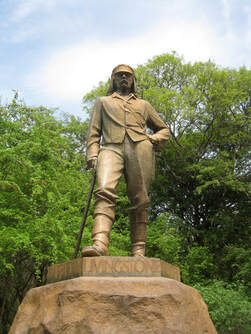0 Comments
George Verwer is the Founder of Operation Mobilisation, which, with over 6,100 people and ships ministering in over 110 nations, is one of the largest Missions in the world today. OM's Logos Hope Mission ship is in Durban now and is coming to Richards Bay, East London, Port Elizabeth and Cape throughout May and June. Peter Hammond met up with George Verwer during his recent ministry tour to South Africa.
 CULTURAL PERFORMANCES BY THE EUROCHOIR, HISTORIC TOUR of the HUGUENOT MUSEUM & MONUMENT and REFORMATION CELEBRATION SERVICES To download a high resolution poster, click here (11.58MB) To download a low resolution poster, click here (544KB) To download the GCC Leaflet click here International Inspiration The Eurochoir is unique in every way. With over 150 members drawn from Belgium, France, Germany, the Netherlands, Switzerland and Romania, this youth choir has thrilled audiences throughout the world with their multilingual, varied, colourful and captivating concerts. You can see more about them at their website: www.eurochor.com. This choir is affiliated to KwaSizabantu Mission, who has a fascinating story of dynamic churches that were birthed from Zululand!  To view this article as a PowerPoint, with pictures on Slideshare, click here. Enslaved Samuel Crowther (1809 - 1891), was born in Yorubaland (modern Western Nigeria). Along with his mother, brother and entire village, he was captured by Muslim Fulani slave raiders and sold to a Portuguese trader for transport across the Atlantic. Freed Samuel was rescued by a British naval squadron and put ashore at Freetown in 1822. This West-African country of Sierra Leone had been established by British Evangelicals to serve as a haven for freed slaves.  To view this article as a PowerPoint, click here. To view this article as a video, click here. To listen to the audio, click here. Famous English cricketer turned pioneer missionary, Charles T. Studd (1860 – 1931), had captained the Eton and Cambridge cricket teams and then had played for the All English in Australia. He was converted during the Evangelical Revival of 1880 under the ministry of D.L. Moody. He gave up everything and went as a missionary to China in 1885. There he met Priscilla Stewart and all four of their children were born in the heart of China.  To view the video of this article Click Here. To listen to the audio of this article Click Here. To view the PowerPoint with pictures, click here. The slave trade in the early 19th century presented a monumental ethical challenge and an apparently insurmountable obstacle to missionary outreaches in Africa. The abolition of the slave trade helped prepare the way for the 19th century to become the greatest century for missionary advance. As we battle against great social evils such as abortion, pornography and persecution and work for Reformation, the overwhelming opposition and pressure can drive one to exhaustion and a temptation to give up the fight. William Wilberforce – the Reformer who led the campaign to abolish the slave trade and to set those in bondage free – was persistently slandered in the media, threatened, physically assaulted and even the target of attempted murder. Yet he persevered and, after a lifetime crusade, his steadfastness was rewarded with the liberation of all slaves in the British Empire. At this critical stage in history Christians need to learn from one of the greatest Christian statesmen how, in the face of constant division and opposition, he succeeded in abolishing the slave trade. Never have there been so many incredible opportunities for missionary work worldwide, yet there are tens of thousands of vacancies waiting to be filled on the mission field today. The harvest has never been so large – and the workers are frustratingly few.
Finding suitable missionary volunteers has never been easy – nor is it likely to get any easier. Missionary service demands dedication, determination and discipline – and these qualities are basically rejected by the television generation.  William Burns (1815 – 1868) was born, the third son, to Christian parents, his father being a minister in the Church of Scotland. His favourite book was Pilgrim’s Progress. Upon entering University in Aberdeen to study law, William Burns was converted after receiving a letter from his sisters. From the moment of his conversion, he was aware of a call to the ministry of the Gospel. He completed theological training in Glasgow and helped in the formation of the Students Missionary Society. When the Fire of the Holy Spirit Came Down In 1839, just before his 24th birthday, he was licensed to preach as a probationer for the ministry. Robert Murray M’Cheyne, the young Godly minister of St. Peter’s in Dundee, asked Burns to take his place while he was away on a mission to Palestine. William’s ministry during this time was much blessed and while visiting his father’s church at Kilsyth, the Holy Spirit so powerfully came upon William as he preached and upon the congregation, that the service lasted for five hours. His message was: “No cross, no crown.” Many people fell to the ground in repentance, calling out for God’s mercy. By the time M’Cheyne came back from Palestine, there were 39 prayer meetings held in connection with the Church every week, five of them composed entirely of little children. A spiritual Revival swept the countryside. Men and women seemed to have but one concern and that was how to be right with God. “After these things I looked, and behold, a great multitude which no one could number, of all nations, tribes, peoples, and tongues standing before the Throne and before the Lamb, clothed with white robes, with palm branches in their hands, and crying out with a loud voice, saying: Salvation belongs to our God who sits on the Throne and to the Lamb!” Revelation 7: 9-10
Unprecedented The great era of missionary advance was the 19th century. The considered judgement of church historian Kenneth Scott Latourette is that: “Never had any other set of ideas, religious or secular, been propagated over so wide an area by so many professional agents maintained by the unconstrained donations of so many millions of individuals.”  To view this article as a PowerPoint, click here. To view another article related to this article as a PowerPoint, click here. To see a video related to this article, click here. To see another video related to this article click here. To listen to the lecture of this article, click here. To listen to another lecture related to this article click here. David Livingstone (1813-1873), was a great missionary pioneer pathfinder whose greatest desire was granted only after his death: the eradication of the slave trade and the opening up of Africa to Christianity and lawful commerce. Livingstone the Liberator He had the grace to see that his mission was part of a divine plan to set many souls free from slavery, both physical and spiritual. Livingstone’s great goal of bringing to the world’s attention the scourge of the Islamic slave trade in Africa was achieved largely through the work of his convert, American journalist Henry Morton Stanley. |
More Articles
All
Archives
December 2022
|
"And Jesus came and spoke to them, saying, “All authority has been given to Me in heaven and on earth.
Go therefore and make disciples of all the nations, baptizing them in the name of the Father and of the Son and of the Holy Spirit,
teaching them to observe all things that I have commanded you; and lo, I am with you always, even to the end of the age.” Amen.” Matthew 28: 18-20
Go therefore and make disciples of all the nations, baptizing them in the name of the Father and of the Son and of the Holy Spirit,
teaching them to observe all things that I have commanded you; and lo, I am with you always, even to the end of the age.” Amen.” Matthew 28: 18-20
|
P.O.Box 74 Newlands 7725
Cape Town South Africa |
|

 RSS Feed
RSS Feed
